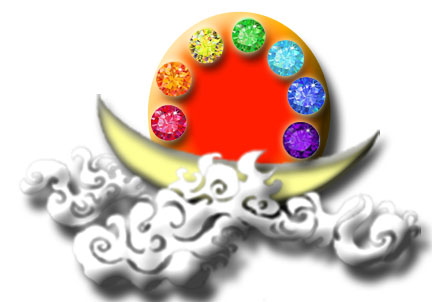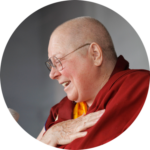
On February 17, 2024 we continued our study of DCB22- Expounding the Absolute Truth through the Text of the Heart Sutra-I by looking at examples of how Avalokiteshvara saves living beings, what is the mission and nature of bodhisattvas, and the meaning of “practice” to a Buddhist.
How Does Avalokiteshvara Save Living Beings?
We discussed several examples of how Avalokiteshvara Bodhisattva saves living beings including the stories of Yu Jiayao’s escape from prison, the green tea magnate Que Daoxiu’s escape from a cave, how a son was able to help his mother reach the higher levels of the Pure Land, and the miraculous healing of Wu Fenbi. We not only learned what Avalokiteshvara can do to help us, but also what we must do to receive her help.
What Is an “Icchantika”?
The Buddha Master explained the meaning of the term “icchantika” in Buddhism: “. . . anyone who pierces the body of a Buddha causing bleeding, pierces the body of an Arhat causing bleeding, commits patricide, commits matricide, or commits other such similarly heinous acts is an icchantika. Icchantikas cannot ascend to the World of Ultimate Bliss even if they chant the name of Amitabha Buddha.” Another heinous act not listed here, but often included, is causing a schism in the Sangha. This gives thought to what our position should be on related ethical matters.
CLICK for related article on euthanasia of pets.
CLICK for related article on suicide.
What Is the Real Meaning of the Term Bodhisattva?
The discussion also covered the meaning of both “bodhi” and “Sattva” and who was qualified to be called a “bodhisattva.” We saw how even bodhisattvas still have some shortcomings based on their varying grades of realization and that they use a variety of methods or skillful means to save beings according to the unique circumstances of the situation. However, we found that bodhisattvas continue to cultivate themselves and learn Dharmas, following the methods of the Buddhas to save others and pursue the attainment of completely perfect, supreme enlightenment and thus become Buddhas.
What is the Meaning of “Practicing Deeply”?
We first considered how “practice,” in the Buddhist context, is the specific actions of our three karmas–what we think, speak, and do, the activities of our body, speech, and mind or our behavior. We then looked at what these three karmas or our behavior is called when it corresponds with all the teachings and doctrines of all Buddhas and Bodhisattvas. Our Buddha Master told us that “It is called yoga when our body, speech, and mind are brought into unified correspondence with the actions of all Buddhas and Bodhisattvas, when our body, speech, and mind correspond with all of the teachings of all Buddhas.”
Next we looked at the differences in terms of “practice” between holy and ordinary people. “The practice of holy ones is to act according to the teachings and guidance of the Buddhas so as to benefit sentient beings.” But, “Ordinary humans are primarily attached to a notion of self. . . They mainly take the unreal to be real. They regard as their bodhicitta all of their differentiating thoughts, their attachment to worldly phenomena, and so on, stemming from their eyes, ears, nose, tongue, body, and mind, and from their five aggregates.”
What is Meant by “Causal Stage” of Practice?
The Buddha Master said that “What is meant by “causal stage” is when practice has not yet sprouted forth from the seeds planted and the causal state has just been activated; that is, when the intent has just been generated and the cause has just been activated.” This is the stage that happens before one becomes a holy person. The bulk of the remaining discussion dealt with how Avalokiteshvara practiced to become a bodhisattva: “She engaged in the Dharma-practice of using Her auditory sense-base cultivated power to inwardly observe the purity and equality of intrinsic nature. . . To state this in even more common terms so that you will very easily understand, all stray thoughts have completely stopped. There is no movement of mind or movement of body. The three karmas are all still. Immersed in tranquility where there is not one single thing, not thinking of good, not thinking of evil, applying the cultivated power of the ear-base in an equality-based, non-differentiating manner, one observes with illumination ‘What is our original appearance’ “?
Was Avalokiteshvara’s Method of Practice the Only Way to Become Accomplished?
We found that it was not. “Among our Buddhas and Bodhisattvas, there are numerous states of accomplishment. Does this mean that we should observe sounds in this manner from now on as we learn from Buddha? This only relates to Avalokiteshvara Bodhisattva. Ancient Buddhas and Bodhisattvas adopted various methods to become accomplished. There is the method of observing water. Through watching water, one attains a state of dhyana and becomes accomplished. There is the method of observing the sun.” There are others. The Buddha Master has recommended that we study the Surangama Sutra. It tells how many of the greatest Bodhisattvas told how they achieved this state.
CLICK for article on Surangama Sutra.
He also provided an example of a Chan/Zen Sect practice and explained how it works.
Next:
We will continue this discussion next week at our February 24 ZOOM session starting at 9:00 am exploring how the methods of the various sects or schools of Buddhism work and what it means to practice in the “Dharma-Ending Age” we now live in.
“Avalokitesvara Bodhisattva, when practicing deeply the prajna-paramita, illuminated the five aggregates, saw that they are all empty, and crossed beyond all suffering and adversity.”
DCB22-Expounding the Absolute Truth through the Text of the Heart Sutra–I and C41-Three Principal Stages & Paths of Buddhist Practice
The recording of the February 17 class is now available. You must be enrolled in DCB22 in one of the membership programs at the LFBCS to access the course materials, questions covered (in parenthesis), and/or the class recordings. Please note that these links will only work if you are logged into LFBCS with your membership Identification number AND are enrolled in this class. Please note that Lessons 6A and 6B are part of Course C41.
February 17, 2024: Lesson 9A-The Great Stage–Wisdom Path of the right view of emptiness, Expounding the Absolute Truth through the Text of the Heart Sutra–I, “Practicing Deeply”, (51-58) and (HERE) for recording of class.
February 17, 2024: Lesson 8C-The Great Stage–Wisdom Path of the right view of emptiness, Expounding the Absolute Truth through the Text of the Heart Sutra–I, “Bodhisattva”, (37-50) and (HERE) for recording of class.
February 17, 2024: Lesson 8B-The Great Stage–Wisdom Path of the right view of emptiness, Expounding the Absolute Truth through the Text of the Heart Sutra–I, “Avalokiteshvara”, (31-36) and (HERE) for recording of class.
February 10, 2024: Lesson 8A-The Great Stage–Wisdom Path of the right view of emptiness, Expounding the Absolute Truth through the Text of the Heart Sutra–I, “Avalokiteshvara”, (1-30) and (HERE) for recording of class.
February 3, 2024: Lesson 6B-The Great Stage–Wisdom Path of the right view of emptiness, Expounding the Absolute Truth through the Heart Sutra-Prajna & Dhyana(Ta), (355-369) and HERE for recording of class.
January 20, 2024: Lesson 6A–The Great Stage–Wisdom Path of the right view of emptiness, Expounding the Absolute Truth through the Heart Sutra-Prajna & Dhyana(Ta), (317-354) and HERE for recording of class.
CLICK for article on the entire text of Expounding the Absolute Truth through the Heart Sutra.
CLICK for article with instructions on how to enroll in LFBCS classes and how to register for the ZOOM discussions.



Add comment